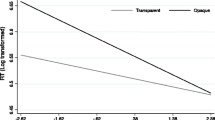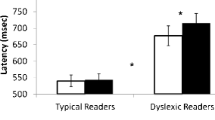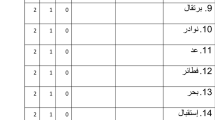Abstract
The present study investigated the involvement of lexical knowledge in pseudoword reading by Italian children aged 8–10. In both lexical decision and reading aloud tasks, inhibitory effects were found on pseudowords derived from high-frequency words in comparison to pseudowords derived from low-frequency words. A group of adult readers showed inhibitory effects on pseudowords based on high-frequency words only in lexical decision. The inhibitory effects were interpreted as due to interference on pseudoword processing caused by lexical activation of a high-frequency base-word. The results support the view that lexical information is exploited even in the development of reading of a transparent orthography.


Similar content being viewed by others
References
Andrews, S. (1997). The effect of orthographic similarity on lexical retrieval: Resolving neighborhood conflicts. Psychonomic Bulletin and Review, 4, 439–461.
Arduino, L. S., & Burani, C. (2004). Neighborhood effects on nonword visual processing in a language with shallow orthography. Journal of Psycholinguistic Research, 33, 75–95.
Balota, D. A., & Chumbley, J. I. (1984). Are lexical decisions a good measure of lexical access? The role of word frequency in the neglected decision stage. Journal of Experimental Psychology: Human Perception and Performance, 10, 340–357.
Barca, L., Ellis, A. W., & Burani, C. (2007). Context-sensitive rules and word naming in Italian children. Reading and Writing: An Interdisciplinary Journal, 20, 495–509.
Burani, C., Marcolini, S., & Stella, G. (2002). How early does morpho-lexical reading develop in readers of a shallow orthography? Brain and Language, 81, 568–586.
Colombo, L., Pasini, M., & Balota, D. A. (2006). Dissociating the influence of familiarity and meaningfulness from word frequency in naming and lexical decision performance. Memory & Cognition, 34, 1312–1324.
Colombo, L., & Tabossi, P. (1992). Strategies and stress assignment: Evidence from a shallow orthography. In R. Frost & L. Katz (Eds.), Orthography, phonology, morphology, and meaning (pp. 319–340). Amsterdam: Elsevier.
Coltheart, M., & Leahy, J. (1996). Assessment of lexical and nonlexical reading abilities in children: Some normative data. Australian Journal of Pshychology, 48, 136–140.
Coltheart, M., Rastle, K., Perry C., Langdon, R., & Ziegler, J. (2001). DRC: A dual route cascaded model of visual word recognition and reading aloud. Psychological Review, 108, 204–256.
Cossu, G. (1999). Biological constraints on literacy acquisition. Reading and Writing, 11, 213–237.
Frederiksen, J. R., & Kroll, J. F. (1976). Spelling and sound: Approaches to the internal lexicon. Journal of Experimental Psychology: Human Perception and Performance, 2, 361–379.
Goswami, U., & Ziegler, J. C. (2006). Fluency, phonology and morphology: A response to the commentaries on becoming literate in different languages. Developmental Science, 9, 451–453.
Goswami, U., Ziegler, J. C., Dalton, L., & Schneider, W. (2001). Pseudohomophone effects and phonological recoding procedures in reading development in English and German. Journal of Memory and Language, 45, 648–664.
Grainger, J., & Jacobs, A. M. (1996). Orthographic processing in visual word recognition: A multiple read-out model. Psychological Review, 103, 518–565.
Harm, M. W., McCandliss, B. D., & Seidenberg, M. S. (2003). Modeling the successes and failures of interventions for disabled readers. Scientific Studies of Reading, 7, 155–182.
Harm, M., & Seidenberg, M. S. (2004). Computing the meanings of words in reading: Cooperative division of labor between visual and phonological processes. Psychological Review, 111, 662–720.
Herdman, C. M., LeFevre, J., & Greenham, S. L. (1994). Implicating the lexicon: Base-word frequency effects in pseudohomophone naming. Journal of Experimental Psychology: Human Perception & Performance, 20, 575–590.
Job, R., Peressotti, F., & Cusinato, A. (1998). Lexical effects in naming pseudowords in shallow orthographies: Further empirical data. Journal of Experimental Psychology: Human Perception and Performance, 24, 622–630.
Laxon, V., Coltheart, V., & Keating, C. (1988). Children find friendly words friendly too: Words with many orthographic neighbors are easier to read and spell. British Journal of Educational Psychology, 58, 103–119.
Laxon, V., Masterson, J., Gallagher, A., & Pay, J. (2002). Children’s reading of words, pseudohomophones, and other nonwords. Quarterly Journal of Experimental Psychology, 55A, 543–565.
Laxon, V., Masterson, J., & Moran, R. (1994). Are children’s representations of words distributed? Effects of orthographic neighborhood size, consistency and regularity of naming. Language and Cognitive Processes, 9, 1–27.
Marconi, L., Ott, M., Pesenti, E., Ratti, D., & Tavella, M. (1993). Lessico elementare. Dati statistici sull’italiano letto e scritto dai bambini delle elementari. Bologna: Zanichelli.
Paulesu, E. (2006). On the advantage of “shallow” orthographies: Number and grain size of the orthographic units or consistency per se? Developmental Science, 9, 443–444.
Paulesu, E., McCrory, E., Fazio, F., Menoncello, L., Brunswick, N., Cappa, S. F., et al. (2000). A cultural effect on brain function. Nature Neuroscience, 3, 91–96.
Perea, M., Rosa, E., & Gomez, C. (2005). The frequency effect for pseudowords in the lexical decision task. Perception & Psychophysics, 67, 301–314.
Taft, M., Hambly, G., & Kinoshita, S. (1986). Visual and auditory recognition of prefixed words. Quarterly Journal of Experimental Psychology: Human Experimental Psychology, 38A, 351–366.
Ziegler, J. C., & Goswami, U. (2005). Reading acquisition, developmental dyslexia and skilled reading across languages: A psycholinguistic grain size theory. Psychological Bullettin, 131, 3–29.
Ziegler, J. C., & Goswami, U. (2006). Becoming literate in different languages: similar problems, different solutions. Developmental Science, 9, 429–453.
Author information
Authors and Affiliations
Corresponding author
Appendix
Appendix
Pseudoword | Base word | Frq | Length | Syll | Gem | Rules | N | Bigr Frq |
|---|---|---|---|---|---|---|---|---|
HF | ||||||||
GIARNO | GIORNO (day) | 2666 | 6 | 2 | 0 | 1 | 1 | 10.91 |
TESPO | TEMPO (time) | 1227 | 5 | 2 | 0 | 0 | 2 | 10.95 |
PAFRE | PADRE (father) | 1043 | 5 | 2 | 0 | 0 | 2 | 10.56 |
TARRA | TERRA (ground) | 952 | 5 | 2 | 1 | 0 | 3 | 11.12 |
STOMIA | STORIA (history) | 462 | 6 | 2 | 0 | 0 | 1 | 11.26 |
PULTO | PUNTO (point) | 434 | 5 | 2 | 0 | 0 | 1 | 10.6 |
PRACO | PRATO (lawn) | 309 | 5 | 2 | 0 | 1 | 1 | 11.22 |
BEBBO | BABBO (daddy) | 305 | 5 | 2 | 1 | 0 | 2 | 9.78 |
STINZA | STANZA (room) | 272 | 6 | 2 | 0 | 0 | 1 | 10.96 |
ROLDO | SOLDO (coin) | 234 | 5 | 2 | 0 | 0 | 1 | 10.45 |
TORPO | CORPO (body) | 233 | 5 | 2 | 0 | 0 | 2 | 10.66 |
CINTRO | CENTRO (center) | 204 | 6 | 2 | 0 | 1 | 2 | 11.3 |
BINCO | BANCO (bench) | 198 | 5 | 2 | 0 | 1 | 2 | 10.84 |
BARNE | CARNE (flesh) | 163 | 5 | 2 | 0 | 0 | 4 | 10.62 |
SCABA | SCALA (staircase) | 156 | 5 | 2 | 0 | 2 | 3 | 10.63 |
CUGISO | CUGINO (cousin) | 453 | 6 | 3 | 0 | 2 | 1 | 10.47 |
BAESTRO | MAESTRO (teacher) | 268 | 7 | 3 | 0 | 0 | 1 | 10.37 |
PAGRONE | PADRONE (master) | 201 | 7 | 3 | 0 | 1 | 1 | 10.87 |
TONIGLIO | CONIGLIO (rabbit) | 145 | 8 | 3 | 0 | 1 | 1 | 10.92 |
CAPPILLO | CAPPELLO (hat) | 141 | 8 | 3 | 2 | 1 | 1 | 10.72 |
PIASETA | PIANETA (planet) | 138 | 7 | 3 | 0 | 0 | 1 | 11.01 |
QUAFERNO | QUADERNO (copy-book) | 96 | 8 | 3 | 0 | 0 | 1 | 10.35 |
FARFILLA | FARFALLA (butterfly) | 96 | 8 | 3 | 1 | 0 | 1 | 10.46 |
DESERCO | DESERTO (desert) | 80 | 7 | 3 | 0 | 1 | 1 | 11.22 |
MERENCA | MERENDA (snack) | 74 | 7 | 3 | 0 | 1 | 1 | 11.23 |
Mean | 422 | 6.08 | 2.4 | 0.2 | 0.52 | 1.52 | 10.78 | |
LF | ||||||||
PANTIA | PANCIA (stomach) | 48 | 6 | 2 | 0 | 0 | 1 | 11.33 |
STAPIO | STADIO (stadium) | 40 | 6 | 2 | 0 | 0 | 1 | 11.07 |
TUORO | TUONO (thunder) | 38 | 5 | 2 | 0 | 0 | 1 | 10.87 |
DIAMMA | FIAMMA (flame) | 37 | 6 | 2 | 1 | 0 | 2 | 10.99 |
SCODO | SCOPO (aim) | 30 | 5 | 2 | 0 | 2 | 2 | 10.85 |
RAPPO | TAPPO (cap) | 22 | 5 | 2 | 1 | 0 | 1 | 10.61 |
TROSO | TRONO (throne) | 22 | 5 | 2 | 0 | 0 | 2 | 11.02 |
SPIFA | SPINA (thorn) | 29 | 5 | 2 | 0 | 0 | 2 | 10.45 |
PILSO | POLSO (wrist) | 16 | 5 | 2 | 0 | 0 | 1 | 10.47 |
TILPA | TALPA (mole) | 13 | 5 | 2 | 0 | 0 | 1 | 10.48 |
GIRRA | BIRRA (beer) | 11 | 5 | 2 | 1 | 1 | 2 | 10.66 |
PELMO | PALMO (palm) | 9 | 5 | 2 | 0 | 0 | 1 | 10.74 |
BREDO | BRODO (broth) | 9 | 5 | 2 | 0 | 0 | 2 | 10.61 |
BITRO | LITRO (litre) | 9 | 5 | 2 | 0 | 0 | 1 | 10.73 |
FUCIPE | FUCILE (rifle) | 27 | 6 | 3 | 0 | 1 | 1 | 10.12 |
DERCHIO | CERCHIO (circle) | 45 | 7 | 2 | 0 | 1 | 1 | 11.09 |
PELCINO | PULCINO (chick) | 48 | 7 | 3 | 0 | 1 | 1 | 11 |
POSTRONA | POLTRONA (arm-chair) | 50 | 8 | 3 | 0 | 0 | 1 | 11.13 |
POLGONE | POLMONE (lung) | 44 | 7 | 3 | 0 | 1 | 1 | 10.5 |
CANDESA | CANDELA (candle) | 44 | 7 | 3 | 0 | 1 | 1 | 11.22 |
PISTOBA | PISTOLA (gun) | 42 | 7 | 3 | 0 | 0 | 1 | 10.56 |
CONFONE | CONFINE (border) | 28 | 7 | 3 | 0 | 1 | 1 | 10.97 |
MEFAGLIA | MEDAGLIA (medal) | 23 | 8 | 3 | 0 | 1 | 1 | 10.46 |
BATTOLLO | BATTELLO (motor vessel) | 22 | 8 | 3 | 2 | 0 | 1 | 10.85 |
CITOGNA | CICOGNA (stork) | 9 | 7 | 3 | 0 | 2 | 1 | 10.85 |
Mean | 28.6 | 6.08 | 2.4 | 0.2 | 0.48 | 1.24 | 10.79 | |
Rights and permissions
About this article
Cite this article
Marcolini, S., Burani, C. & Colombo, L. Lexical effects on children’s pseudoword reading in a transparent orthography. Read Writ 22, 531–544 (2009). https://doi.org/10.1007/s11145-008-9123-0
Received:
Accepted:
Published:
Issue Date:
DOI: https://doi.org/10.1007/s11145-008-9123-0




